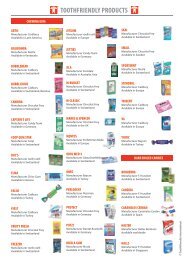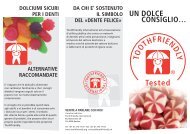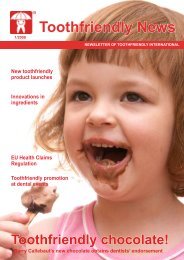TRENDS - Toothfriendly International
TRENDS - Toothfriendly International
TRENDS - Toothfriendly International
Create successful ePaper yourself
Turn your PDF publications into a flip-book with our unique Google optimized e-Paper software.
<strong>Toothfriendly</strong> labeling explained<br />
The trend to mention a product’s contribution to<br />
dental health is gaining momentum among confectionery<br />
manufacturers. This article gives insight on<br />
one special certification mark: the Happy Tooth logo.<br />
Most of the current industry interest in the<br />
<strong>Toothfriendly</strong> concept can be traced back<br />
to Switzerland, where academic research<br />
on sugar-free confectionery has evolved<br />
into a consumer communications effort<br />
– and where the industry has seized upon<br />
it with enthusiasm as a marketing tool. In<br />
particular the Happy Tooth seal on product<br />
labels, initiated over twenty-five years ago,<br />
has gained widespread attention among<br />
confectionery manufacturers.<br />
The Happy Tooth is the brainchild of an alliance<br />
between four Swiss Dental Universities.<br />
In 1989 the partners jointly formed a nonprofit<br />
organization <strong>Toothfriendly</strong> <strong>International</strong><br />
to build awareness of the symbol and<br />
license its use on confectionery products.<br />
Companies taking part in the <strong>Toothfriendly</strong><br />
program have the symbol embossed on<br />
their product labels and can use it in their<br />
marketing.<br />
The symbol signifies that a product has<br />
been tested in an accredited laboratory and<br />
guarantees that it has no risk to teeth. To<br />
be eligible to carry the Happy Tooth logo<br />
products must be:<br />
• non-cariogenic<br />
• non-erosive<br />
The products of confectionery manufacturers<br />
such as Ricola and Cadbury were among<br />
the very first to carry the Happy Tooth symbol<br />
on their labels. Today, more than two<br />
decades later, more than 50 companies offer<br />
brands that carry the symbol worldwide.<br />
Credibility through science<br />
There is probably no-one who has done<br />
more to popularize the <strong>Toothfriendly</strong><br />
concept than Prof. Bernhard Guggenheim<br />
of the Center for Dental and Oral Medicine<br />
and Cranio-Maxillofacial Surgery at the<br />
University of Zurich. While being widelyrecognized<br />
as one of the world’s experts on<br />
oral microbiology, it was not enough for him<br />
to engage scientific projects only: “Our big<br />
aim was to get the confectionery industry<br />
involved. In the early 1980’s it was crucial to<br />
create marketing mechanisms to support<br />
the take-off of sugar-free sweets”, recalls<br />
Prof. Guggenheim.<br />
6 <strong>Toothfriendly</strong> News 1/2010<br />
The “toothfriendliness”<br />
of a product<br />
is tested by means<br />
of intraoral pH<br />
telemetry. Applying<br />
a standardized<br />
method, the plaque<br />
pH is measured<br />
at least in four<br />
volunteers during<br />
and for 30 minutes<br />
after consumption.<br />
The product should<br />
not lower plaque-pH<br />
below 5.7.<br />
Prof. Guggenheim has dedicated much of<br />
the past 25 years to deepening the industry’s<br />
understanding of the criteria and test<br />
method behind the <strong>Toothfriendly</strong> endorsement.<br />
Even today, the most reliable way to test the<br />
dental risks of a product is by means of the<br />
intraoral plaque-pH telemetry method. This<br />
test is generally recognized by the dental<br />
profession for identifying foods or food<br />
ingredients that cannot be fermented by<br />
the micro-organisms in the dental plaque to<br />
tooth-destroying acids.<br />
Companies which apply for the Happy<br />
Tooth seal have their products tested by an<br />
accredited laboratory such as the University<br />
of Zurich. Accepted laboratories use a standardized<br />
procedure and have had their data<br />
quality verified by <strong>Toothfriendly</strong> <strong>International</strong>.<br />
The downside of the acknowledged<br />
method is its relatively high cost. Universities<br />
which run the test charge approximately<br />
4500 Euros for the first product (a full test<br />
with 4-6 volunteers) and around 1500 Euros<br />
for further flavors of the same product range<br />
(a follow-up test).<br />
Dentists’ endorsement<br />
The early commitment of the dental community<br />
has paid dividends in making the<br />
Happy Tooth symbol a credible marketing<br />
tool for confectionery manufacturers. A<br />
recent survey conducted among German<br />
dental professionals revealed that 83% of<br />
dentists claim to inform their patients of the<br />
meaning of the logo.<br />
“It’s extremely satisfying that the message<br />
is getting out through opinion leaders,” says<br />
Prof. Guggenheim. “The fact that there now<br />
are healthier alternatives to sugar confectionery<br />
has not only boosted the industry’s<br />
own profits, but it has also helped to decline<br />
the caries prevalence in many countries.”<br />
Prof. Guggenheim firmly awards credit to<br />
key opinion leaders who have stood behind<br />
the program since the very beginning:<br />
“We are now finally past those days when<br />
dentists condemned all sweets for rotting<br />
teeth. Today, dental professionals have<br />
embraced the <strong>Toothfriendly</strong> promotion on<br />
a very personal level, and many even keep a<br />
regular stock of toothfriendly sweets at their<br />
own practice.”<br />
<strong>Toothfriendly</strong> vs. sugar-free<br />
In the past twenty-five years the sugar-free<br />
message has become an everyday marketing<br />
message – particularly in the chewing<br />
gum business, where it seems hard to find<br />
a product that doesn’t mention dental<br />
benefits – but not necessarily in the way<br />
the dentists who initiated the <strong>Toothfriendly</strong><br />
program had originally envisaged.<br />
A visit to any European supermarket will<br />
reveal at least as many products that<br />
promote themselves as sugar-free but do<br />
not carry the Happy Tooth symbol as there<br />
are products that do carry the logo. Some<br />
are from small companies but many of the<br />
brands carrying dental claims without the<br />
<strong>Toothfriendly</strong> endorsements are produced<br />
by market leaders, such as Wrigley.<br />
Picture: BENEO-Palatinit









